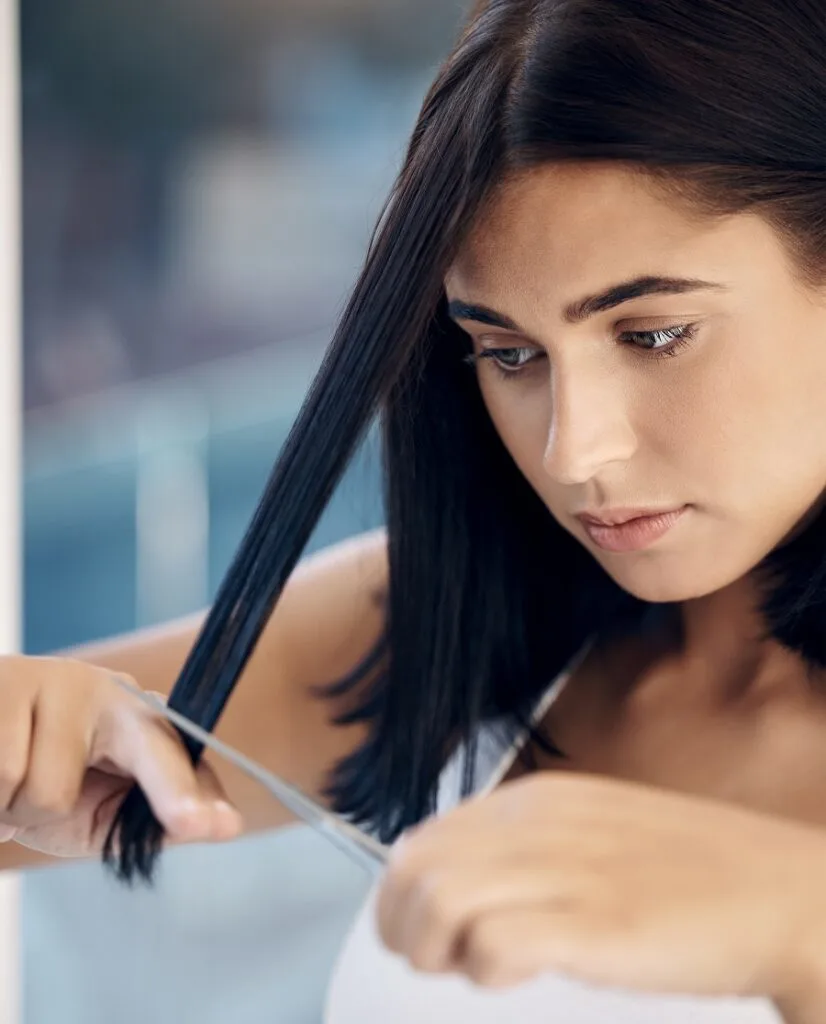Thinking about changing your hairstyle? Layers on medium-length hair are the answer. It may seem like something only a stylist should do, but it can actually be done at home.
Layers add extra style and flexibility to medium hair. You can wear it straight today, curly tomorrow, and always look your best.
With just a few tools and a few simple steps, you can create a layered look for medium hair yourself, even if it’s your first attempt.
Are you ready to try it out? You don’t have to go to the salon every time you need a fresh style. Let’s see how to cut layers of medium-length hair yourself.
How to cut layers of medium hair yourself
Medium-length layered hairstyles add vibrancy and depth to your hair, create shadows and highlights, and make your hair look more vibrant and dynamic. Here’s how to cut shoulder-length hair with layers.
1. Prepare

Cutting your own hair can be nerve-wracking. Therefore, proper preparation is necessary to get the desired result and make it an enjoyable experience.
First of all, you need to make sure that you have all the necessary tools. The quality of the tool can have a significant impact on the final result.
Here are the tools you need to cut layers on medium hair:
Sharp hair scissors: Using regular household scissors can result in uneven cuts and damage your hair. Invest in professional hair cutting scissors specifically designed for trimming hair. Achieve precise, smooth cuts without causing split ends.
Fine tooth comb: A fine-toothed comb will help you smoothly detangle your hair and maintain control when cutting. It helps achieve a straight cut and evenly distributes the hair.
Hair tie or clip: These will help you cut your hair. Sectioning is important in managing your haircut step by step, especially when layering. Helps keep uncut hair out of the way.
Water spritz bottle: Keeping your hair slightly damp will make it easier to cut and manage. A spritz bottle allows you to moisten sections of your hair to ensure an even cut.
Once you have all the tools, it’s time to create the appropriate environment. Cutting your own hair can be nerve-wracking, so having the right tools is just as important.
Take a deep breath and find a well-lit area with a decent-sized mirror. It’s best to do it during the day, as natural light shows the hair most accurately.
Use a bright light to clearly see if you are cutting layers in the evening or at night.
Play calming music and wear clothes that you don’t mind getting a little hair on. T-shirts and tops for her with a simple neckline are a better choice because loose hair won’t get tangled.
Stand on a surface that is easy to clean. The hair will need to be trimmed, but cleaning it will be easier if you place it in a manageable location.
2. Arrange your hair
Once all the tools are ready, decide on the type of layer. The cutting style is mainly determined by the style you choose.
It is possible to cut long layers even with medium hair, but if your hair is shorter than your shoulders, we recommend choosing short to medium layers.
You can also mix up layered styles. For example, you can cut a medium-layered bob with or without bangs, or vary the length from the shoulders to the collarbone layers.
Once you have chosen your style, clean your hair for a successful cut. Make sure your hair is washed, as natural oils and product buildup can weigh down your roots.
It’s best to work while your hair is dry, especially if you have curly or wavy hair. This gives you more control and allows you to better understand what the end result will look like.
For straight hair, you can also cut it 80% air dry or slightly damp to create sharp, precise lines. Comb your hair to remove tangles.
3. Divide your hair into sections

Work mainly on the front and top parts of your hair to create beautiful, bouncy layers. Leaving the bottom part without layers will help preserve the volume and volume of your hair.
So, before you start cutting, section off the top two-thirds of your hair and cut off the bottom third of your hair. We’ll work on the bottom part later.
Next, part your hair down the middle and divide the top two-thirds of your hair into two equal parts. First decide which side you will be working on. For this guide, we’ll start on the right side of your head. Now you’re ready to start layering.
4. Gently cut the shortest layers
Using a comb, take a half-inch section from the center section of your hair to the right. This section will be your shortest layer, so decide how long you want it to be.
The first layer, ending between the cheekbones and chin, looks flattering on most face shapes.
Lift the parted hair away from your face at a 90-degree angle and hold the hair firmly between your index and middle fingers.
First cut your hair straight to the side, then go back and use the point cut method to create soft, blended ends.
For those who are not familiar with point cuts, they are a technique where the hair is cut vertically rather than horizontally. This allows layers to transition smoothly and blend without creating clumps or dull lines.
Repeat this step with a half-inch section on the left side of your hair, checking to see if both sides are the same length.
5. Add lower layers

Now go back to the right side of the hair and start working on another layer. Take a 1-inch section of hair below the previous section and cut it slightly longer than the first layer using the same steps as above.
Add the bottom layer one inch at a time to each side of your hair. Small sections allow you to blend the layers seamlessly, but if you want each layer to be more defined, you can use larger sections to cut them.
A good rule of thumb is to make small, careful cuts and work slowly. You can always trim your hair further if you want to shorten the length, but if you cut it too short, you won’t be able to grow it back. If you cut wet hair, keep in mind that your hair will look even shorter when it dries.
Check regularly to make sure the layers on both sides look even, and make small point cuts to match the length.
6. Trim the bottom part of your hair
Now that you’ve achieved shape, softness, and movement in the top layer of your hair, it’s time to tackle the bottom part of your hair sectioned in step three.
Clip or tie the top two-thirds of your layered hair back and let the bottom third fall.
Use a comb to part your hair in the middle and bring both sides to a visible position in front of your shoulders.
These two sections are the longest parts of your hair, and it’s up to you how much or how little you want to trim.
Take a section of your hair on one side and gently pull it away from your face at a 90 degree angle. As before, hold the hair between your fingers and cut it horizontally.
Do the same on the other side of your hair, then make a point cut to make sure both sides are even. To preserve your hair’s natural volume, leave the bottom third section unlayered.
7. Evaluate and adjust layers

After successfully cutting both the top and bottom part of the hair, the next thing to do is to evaluate your work.
Remove all clips and part your hair in the middle. Comb each side neatly forward and note the noticeable difference between the two sides.
Additionally, make sure that the top and front layers gradually blend into the overall length of your hair. A good tip is to stand in front of the mirror and look at your new hairstyle from all angles.
If your layers look choppy, make point cuts to soften the transition between the two lengths.
Add trims and tweaks until you have layers of symmetrical medium hair that you’re happy with. You can also curl your hair in medium layers for more styling options.
Maintain layers for medium-length hair

Layers can give your hair life and bounce, but they can also cause unevenness over time. Whether you keep layers on your medium-length hair depends on the type of layers you have.
For example, you can easily maintain layers on medium-length hair with simple layers parted on the side, but bold choppy layers can require a lot of maintenance.
Consider getting regular trims every 6 to 8 weeks. It keeps the layers sharp and prevents them from growing into irregular shapes.
Use a round brush to blow-dry your hair inward to frame your face. Dry with a hairdryer, starting at the root of each layer and rolling the brush all the way to the end.
Don’t forget to use a heat protectant to keep your hair healthy and prevent frizz.
If you have curly hair, a diffuser is also a great option. Diffusing the ends of each layer will add volume to your hair and add bounce to medium-length hair.
By following the steps outlined in this guide, you can now cut layers of medium-length hair yourself and confidently maintain them at home. Cut carefully and confidently to get the perfect face-framing layers at home.


